You searched for: 在线炒股配资系统快速搭建【TG���������@EK7676】平台包网搭建在线炒股配资系统快速搭建【TG���������@EK7676】平台包网搭建18tDv7uOwe
<< Previous | Displaying results 176-200 of 246 for "在线炒股配资系统快速搭建【TG���������@EK7676】平台包网搭建在线炒股配资系统快速搭建【TG���������@EK7676】平台包网搭建18tDv7uOwe" | Next >>
-
Karl Lange
ID CardKarl was born in the north German port of Hamburg. His father was American, and his mother was German. Soon after Karl was born, his father returned to the United States and a little later, his parents were divorced. Karl left school when he was 14 and worked as a shop apprentice. 1933-39: In 1935 an informer told the police about Karl's secret meetings with a 15-year-old youth, and he was arrested under the criminal code's paragraph 175, which defined homosexuality as an "unnatural" act. Though this law…
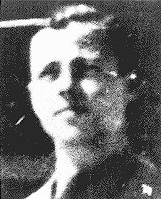
-
Helene Gotthold
ID CardHelene lived in Herne and Bochum in western Germany, where she was married to a coal miner who was unemployed between 1927 and 1938. Following their disillusionment with the Lutheran Church during World War I, Helene, who was a nurse, and her husband became Jehovah's Witnesses in 1926. Together, they raised their two children according to the teachings of the Scripture. 1933-39: Under the Nazis, Jehovah's Witnesses were persecuted for their missionary work and because they believed their sole allegiance…

-
Magdalena Kusserow
ID CardOne of 11 children, Magdalena was raised as a Jehovah's Witness. When she was 7, her family moved to the small town of Bad Lippspringe. Her father was a retired postal official and her mother was a teacher. Their home was known as "The Golden Age" because it was the headquarters of the local Jehovah's Witness congregation. By age 8 Magdalena could recite many Bible verses by heart. 1933-39: The Kusserow's loyalty was to Jehovah, so the Nazis marked them as enemies. At 12 Magdalena joined her parents and…

-
Zofia Yamaika
ID CardZofia was raised in a well-to-do, prominent Hasidic Jewish family in Warsaw. Uneasy with the constant tension between the Polish people and the Jewish minority, Zofia joined the communist student club Spartacus when she was a teenager. Spartacus actively campaigned against the growing fascist movement in Europe. 1933-39: When Warsaw surrendered to the Germans on September 28, 1939, Zofia was 14 years old. She stopped going to school. Though the Nazis banned Spartacus, she secretly helped to revive the…
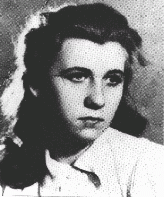
-
David Mendel Petranker
ID CardDavid was one of eight children born to observant Jewish parents living in the small town of Delyatin. During World War I, David served in the Austrian army. Following the war, he married Frieda Gaenger and moved to Stanislav [Stanislawow]. There, David worked in his father-in-law's lumber business. 1933-39: David had a post as vice-director of the forestry ministry's regional office. His three daughters attended private schools. David was an ardent Zionist, and looked forward to moving his family to…
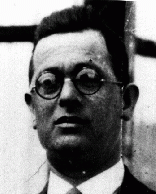
-
Lajos Nagy
ID CardThe Nagys were one of several Jewish families in Zagyvapalfalva, a town 45 miles from Budapest. They owned a general store that served the many coal miners in the mountain valley town. As a young man, Lajos served with the Hungarian army in World War I. He then studied in Budapest to be a diplomat, but a 1920 law restricting the number of Jews in certain professions kept him from pursuing his career. 1933-39: Lajos's father passed away. Lajos took over the general store in Zagypalfalva with his bride,…
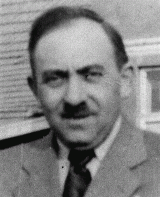
-
Harry Toporek
ID CardHarry was one of eight children born to a large Jewish family in the Polish town of Lask, 18 miles southwest of Lodz. The Toporeks operated a tannery. Harry attended a public school in the mornings and a religious school in the afternoons. After graduating from secondary school, Harry helped his family in the tannery. 1933-39: On Friday, September 1, 1939, Germany invaded Poland, and by Sunday German planes began bombing Lask. Harry and his family couldn't fight the planes so they fled into the fields.…
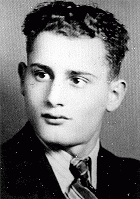
-
Mendel Felman
ID CardOne of seven children, Mendel was raised in a Yiddish-speaking, religious Jewish home in Sokolow Podlaski, a manufacturing town in central Poland with a large Jewish population of about 5,000. Mendel's parents ran a grain business. As a teenager, Mendel liked to play chess, and he completed his public schooling in Sokolow Podlaski in 1931. 1933-39: After finishing middle school, Mendel went to work in his parents' business. When he was 18, he fell in love with Frieda Altman who was in the same Zionist…

-
Sevek Fishman
ID CardSevek's religious Jewish family owned a haberdashery business in Kaluszyn, a suburb of Warsaw. The oldest of six children (three boys and three girls), Sevek completed high school and was then apprenticed to a tailor. 1933-39: Each Friday, before the Sabbath began, Sevek's mother asked the neighbors if they had enough food for the Sabbath. If they didn't, she brought them a meal. Although Sevek belonged to a non-religious Zionist group, Ha Shomer ha-Tsa'ir, and didn't wear a skullcap like religious Jews,…
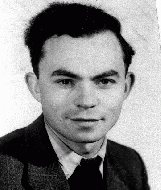
-
Majlech Kisielnicki
ID CardThe second of three children, Majlech was born to Jewish parents living 35 miles east of Warsaw in the small, predominantly Jewish town of Kaluszyn. Majlech's father owned a wholesale grocery store, a restaurant and a gas station, all of which were located on the heavily traveled main road. Majlech attended public elementary school and also received religious instruction. 1933-39: Majlech and his pals, Mindele, Sara and Adam loved to discuss politics. They'd heard the Polish propaganda claiming that…
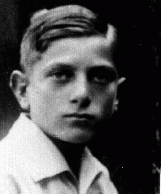
-
Edek Blonder
ID CardThe Blonder family lived in a two-room apartment in the back of a store. Edek was the third of eight children. His father eked out a meager living by tutoring students in Jewish subjects, and beginning in 1930 he worked distributing food vouchers to the poor. 1933-39: After graduating from secondary school, Edek was invited to play soccer professionally on the local Club Maccabi team, which was part of a Jewish soccer league. Club Maccabi arranged for him to attend trade school to learn cabinet making at…

-
Leon Kusmirek
ID CardLeon was the oldest of two boys born to a Jewish family in Zgierz, a central Polish town in the heart of Poland's textile producing region. The family lived at 15 Konstantynowska Street. Leon's father worked at a textile factory. At age 7, Leon began attending public school in the morning and religious school in the afternoon. 1933-39: On Friday, September 1, 1939, Leon's mother had just returned from the market when the family saw German planes. On Sunday they flew over again, lower, panicking the city.…
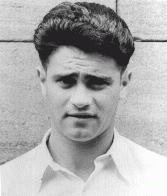
-
Frederick Fleszar
ID CardFrederick was the oldest of two sons born to Polish immigrants in Syracuse, New York. In 1922 Frederick's father, who was a musician, moved the family back to Poland where they settled in Poznan. There Frederick started public school and was accepted to the boys section of the prestigious Poznan Cathedral Choir. 1933-39: In 1933, at age 17, Frederick graduated from secondary school and enrolled in medical school at the university at Poznan. He sang with the choir for the last time the day he graduated…

-
Shmuel David Bursztyn
ID CardRaised by Yiddish-speaking, religious Jewish parents in the town of Pultusk in central Poland, Shmuel married in the late 1890s and moved with his wife, Gisha, to the city of Warsaw. Shmuel owned and operated a bakery on Zamenhofa Street. In 1920 the Bursztyns and their eight children moved to larger quarters in a two-bedroom apartment at 47 Mila Street in the Jewish section of the city. 1933-39: By 1939 six of Shmuel's children were grown and on their own. Only his youngest son and daughter still lived…
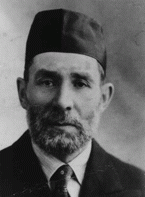
-
Gyula (Gyuszi) Brieger
ID CardGyula was also known as Gyuszi. He was born into a large religious Jewish family in the village of Nagyhalasz in northeastern Hungary. The Briegers spoke both Yiddish and Hungarian. After Gyula's mother died, his father remarried and the family moved to the town of Nyiregyhaza, where his father owned and operated a hardware store. Nyiregyhaza had a Jewish population of 5,000. 1933-39: Gyula was the second oldest son in a household of seven children. Nyiregyhaza was a rural town in which people still used…
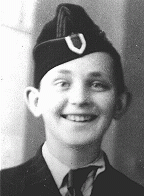
-
Wilma Schlesinger Mahrer
ID CardWilma was the oldest of two daughters born to German-speaking Jewish parents. She married Gyula Mahrer, a Hungarian Jew who had fought in the Hungarian army during World War I. The couple lived in the Hungarian capital of Budapest, where they raised two daughters. The Mahrers lived near their eldest daughter, Kornelia, who had married in 1928. 1933-39: Wilma's first grandchild, Maria, was born on Wilma's 55th birthday. By 1936 Wilma had five grandchildren, three of whom lived in Budapest with her daughter…
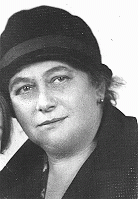
-
Refugees Today
ArticleAs of mid-2022, there were about 27 million refugees. Learn more about these refugees, the violence they face, and the global impact of the refugee crisis.

-
Ruth Berkowicz Segal describes deciding to leave Warsaw shortly after the outbreak of war
Oral HistoryWhen German forces invaded Poland in September 1939, Ruth's father fled to eastern Poland. Upon the Soviet occupation of eastern Poland, he fled to Lithuania. Ruth left Warsaw with two friends to find her father and later joined him in Vilna. After Soviet forces occupied Lithuania, Ruth and her father obtained transit visas for Japan, but only Ruth obtained a Soviet exit visa. Her father insisted she leave and not wait for him. Ruth traveled by the Trans-Siberian Railroad across the Soviet Union to…
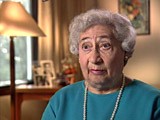
-
George Salton describes liberation by American forces
Oral HistoryGeorge was liberated by the American forces in May 1945. He had spent three years during the war in ten different concentration camps. In 1945 he was in the Woebbelin camp in Germany. After liberation, he spent over two years in various displaced persons camps. George immigrated to the United States in October 1947.
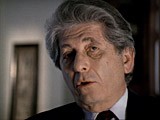
-
Abraham Bomba describes gassing operations at Treblinka
Oral HistoryDescribes gassing operations at Treblinka
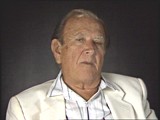
-
John Woodruff describes winning an Olympic medal
Oral HistoryIn 1936, John Woodruff was one of 18 African Americans on the US Olympic team competing in Berlin. He won the gold medal for the men's 800-meter race. In this clip he describes his feelings upon winning the medal. Interview date: May 15, 1996
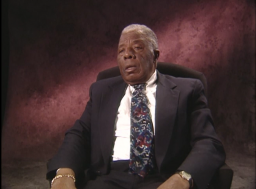
-
Olympic athlete John Woodruff describes his experiences of discrimination
Oral HistoryIn 1936, John Woodruff was one of 18 African Americans on the US Olympic team competing in Berlin. He won the gold medal for the men's 800-meter race. In this clip from an interview on May 15, 1996, Woodruff describes his personal experiences of racial discrimination during and after the Olympic Games of 1936.
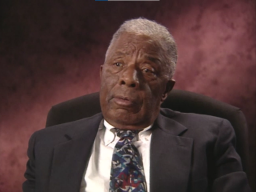
-
Protocols of the Elders of Zion: Key Dates
ArticleExplore a timeline of key events related to the Protocols of the Elders of Zion, the most notorious and widely distributed antisemitic publication of modern times.

-
Theresienstadt: Key Dates
ArticleExplore key dates in the history of the Theresienstadt camp/ghetto, which served multiple purposes during its existence from 1941-45.
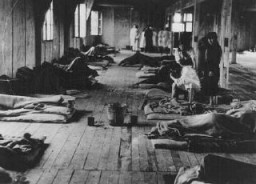
-
Le Chambon-sur-Lignon
ArticleFrom 1940 to 1944, Le Chambon-sur-Lignon and neighboring villages provided shelter to some 5,000 people, among them Jews fleeing persecution.

